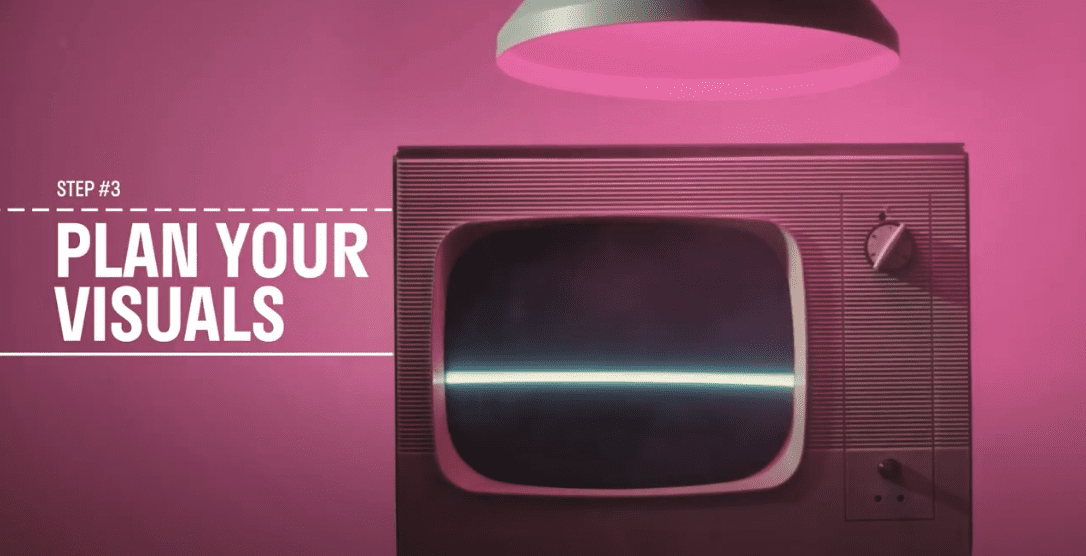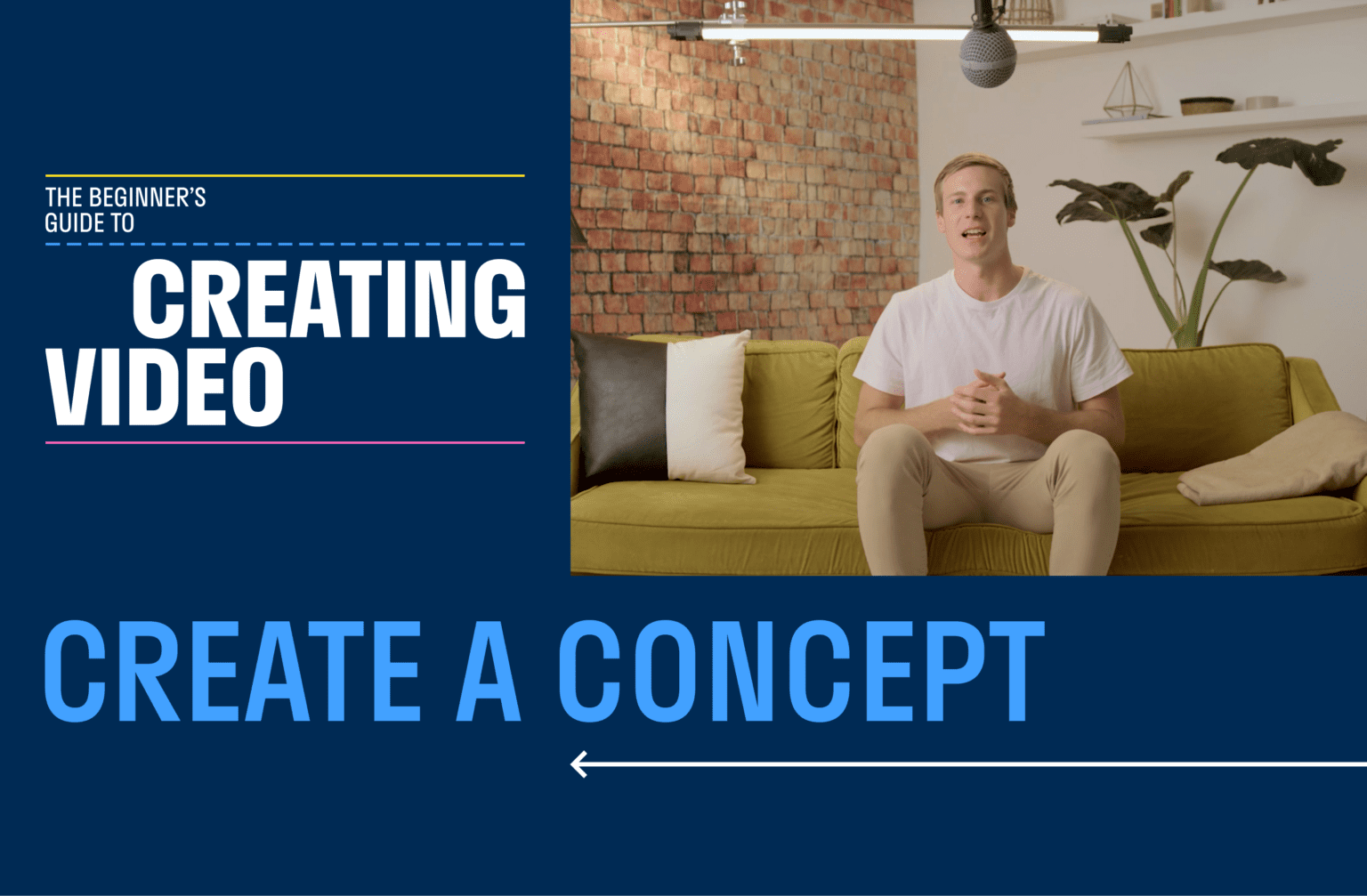Before you embark on any journey into unfamiliar territory, it’s always a good idea to map out your route. When you’re creating videos, your map will take the form of a clearly defined concept. Your video concept will guide what you’ll say and how you say it. You’ll use it throughout the entire process to keep your video heading in the right direction as you create it.
You may have a strong mental image of the story you’re hoping to tell with your video. That’s a great starting point! But before you break out the camera and editing software, you’ll want to get some of those ideas written down. You can use a whiteboard, a computer screen, even a pile of Post-It notes. It doesn’t need to be pretty, and it doesn’t have to be especially orderly. But if you skip this step, you’ll be basically trying to navigate your journey in the dark when you start filming.
When it comes to making videos, a little planning can go a long way. Episode 4 of the Storyblocks original series, The Beginner’s Guide to Creating Video offers tips to map out your video concept. Our own Senior Video Production Specialist, Kyle Miller, explains how to lay the groundwork early and set yourself up for success throughout the entire process.
Step 1: Brainstorm your video concept

The first important step is to define the goals for your video. Are you trying to teach your audience a new skill? Do you want to make them aware of a new product or service? Would you like to inspire them to take a certain action? Identifying your video’s objectives in advance will help you put the right elements in place to achieve your goals.
Next, start thinking about potential concepts based on what you know about the audience for your video. Consider what makes them tick, what they care about, and what will motivate them to take action. Write out words that describe how you want your audience to feel when they watch your video. Then, jot down some phrases that might resonate with them. If you’re stuck, check out some videos from other creators or brands for inspiration.
Maybe you only have a general idea of what you want your video to communicate. That’s ok. Your concept doesn’t need to be fully fleshed-out right away. Bounce your early ideas for a video concept off some willing colleagues or friends. Their feedback will help your concept evolve if you keep the conversation collaborative and explore different directions. And keep an open mind to entirely new ideas that might pop up, too. The best videos often come from unexpected concepts, so don’t be afraid to get a little messy along the way.
Pro tip: Always ask for feedback on your concepts
Once you have a few promising concepts lined up, collect some quick feedback. Confirm which concepts have the best chance to resonate based on your knowledge of your audience. If you work on a team, poll your colleagues to get their opinions. Or better yet, ask your target audience to weigh in. Your goal here is to hone in on your very strongest concept. It can be hard to leave a concept you love on the cutting room floor. But you can’t pursue them all — at least not all in the same video.
Want more tips for crafting a video concept?
Check out Episode 4 of The Beginner’s Guide to Creating Video.
Step 2: Write the script for your video concept

When scripting out your concept, consider which “beats” you want to hit the hardest in your narrative. By “beats,” we mean specific talking points, bits of information, or entire sections of a scene. This can include anything from key takeaways in explainer videos to major plot points in a feature film. Use the placement of these beats as a guide when you’re creating the rest of your script.
Whether your video is completely scripted or centered around a series of interviews, you’ll want to write out the main ideas you want to communicate. One of the most effective ways to do this is by following the classic three-act structure. That sounds more complicated than it really is. All you need to do is make sure your video has a distinct beginning, middle, and end. Sequencing your video in this way will help keep your audience engaged from the start — and keep them watching until the end.
Here are a few things to consider for each section of your video:
- Act 1: Establish the reason why someone might be watching your video in the first place. This is where you’ll need to hook your audience by setting the tone and laying out what’s to come.
- Act 2: Present the rising action and the conflict. This is where you’ll demonstrate the value to your audience. You’ll build-up the tension in this middle section, which will lead to anticipation for the conclusion.
- Act 3: Provide a release from the tension with a clear resolution. Here you’ll reinforce how you want your audience to feel or give them a clear call to action. What do you want your audience to do after they watch?
It’s important to establish structure early in your video, but there isn’t necessarily a one-size-fits-all way to do that. Different types of video concepts call for different levels of scripting. For instance, if the basis of your video is an interview, it doesn’t make sense to write a traditional script. Instead, jot down some bullet points for the key things you want to cover. Then, prepare questions that’ll produce those best soundbites. You’ll need to use your best judgment to figure out just how much scripting is appropriate for your project.
Pro tip: Consider your video’s length before it’s too late
As you’re writing your script, be sure to consider your target length for the video. One way to do this is with a timed “test read” of your script. Basically, you’ll just start a stop watch and then read through your script at roughly the same cadence that the lines will be delivered. If your video will have an interview format, you’ll just need to consider how long your interview questions will take to ask and answer. You can do a mock interview before you start filming to make sure the questions you’ve prepared will yield content that’s the right length for your video.
Want to learn video scripting and structure tips to keep your audience engaged?
Check out Episode 4 of The Beginner’s Guide to Creating Video.
Step 3: Plan your visuals to support your video concept

Taking a video concept from the page to the screen can be a daunting task. You can ease that transition before you record a single frame of footage, though. It just takes a little visualization. Think through what your video will look like and how you might be able to showcase visuals that support your concept. A mood board is a great place to start that process.
Begin by collecting aesthetically similar bits of visual inspiration in a document, spreadsheet, or a project management tool. If you have a strong vision for how specific scenes should look, create a storyboard. That will allow you to organize your visuals right alongside the sections of your video where you want them to appear. Both of these approaches will help you map out how your visual elements will reinforce your video’s message.
Don’t worry if you can’t draw. You can use anything from screen grabs to stick figures to demonstrate the general look of your concept. You aren’t trying to create something that will hang in the Louvre, here. You’re simply assembling a visual framework to follow when you start shooting. Along those same lines, when you’re creating videos quickly, don’t get hung up on creating final draft-quality work for each step of the process. What’s important is that you get your ideas out of your noggin and into a format you can use to guide your work, share your vision, and collaborate along the way.
There will be plenty of opportunities for you to refine things as you create your video. But having a trusty map by your side when you start out will make the journey a whole lot easier.
Need help taking your video concept from page to screen?
Check out Episode 4 of The Beginner’s Guide to Creating Video.
Next time on The Beginner’s Guide to Creating Video…
Storyblocks’ original series, The Beginner’s Guide to Creating Video, is free for you to watch right now. You can binge the whole series in less than an hour, or just pick and choose individual episodes that interest you. Regardless of how you watch it, you’ll pick up tons of tips. Tune in now to learn how you can start making great videos faster than ever before.
Coming up in Episode 5, you’ll learn some video editing basics from the pros. Check it out to explore a few helpful tricks you can use on any editing platform.



